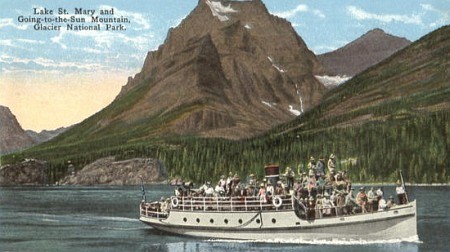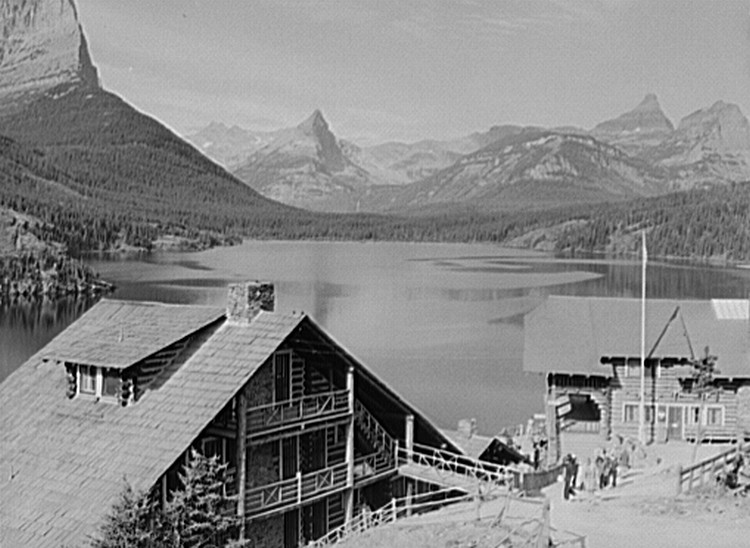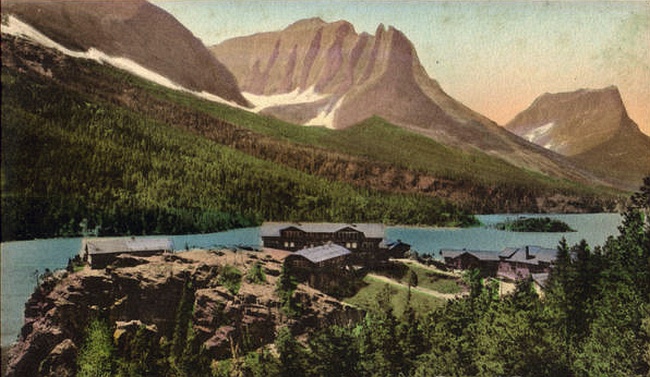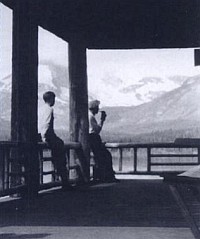The Underused Chalet
Among the Great Northern Railway chalets and lodges at Glacier National Park, Going-to-the-Sun seems to be the first to be occupied by guests. This wasn't at the seeping complex seen in these photos, however, it was a dusty collection of canvas tents called Sun Camp. The Sun Camp served as a work camp for the construction at the nearby chalets; historical writings indicate that it was also used by guests on pack tours as early as 1911.
The lodge buildings were ready to use on a small scale just a year later. This would be steadily added to over the next dozen years, and the future looked bright for Sun Camp. In 1921, no less an authority than Stephen Mather himself predicted that Going-to-the-Sun Highway would necessitate further construction:
...with the completion of the transmountain highway at some future date, the second link of which will be built from the Blackfeet Highway to Going-to-the-Sun Chalets, the travel to this hostelry will increase enormously, and it is safe to predict that eventually a hotel of 500 guests capacity could be operated at Going-to-the-Sun with great success...
He couldn't have been more wrong.
If you've ever visited Walt Disney World in Orlando, Florida, you may have been surprised and perhaps taken aback by the fact that there is no way to drive to the Magic Kingdom section. You may park at Epcot, MGM, and Downtown Disney, but the centerpiece -- the Magic Kingdom with its castle and cast of characters -- is not accessible by automobile. Guests can access it by ferry boat or by light rail only; it requires a greater investment of time and effort. You can't come and go very easily, even by rail from Disney properties.
By doing so, Disney creates the illusion that you are arriving at a place...a special place. This investment of time and effort adds greatly to your perceived value of the destination. Because you can't reach it by car, it's removed from the world you are familiar with. It is therefore unfamiliar, new, different -- and substantially more exciting. Also, you'll tend to stay much longer than if you could simply come and go at your leisure.
This same sense of remoteness and investment of effort existed at Going-to-the-Sun Chalets. Much like the Magic Kingdom decades later, the majority of guests at the Chalets arrived by boat. Reaching the head of the lake at St Mary Chalets, the took an afternoon launch that slowly moved them away from the plains and into the mountains. When they finally arrived at Sun Camp, they found themselves removed from the everyday, in a totally magical and unfamiliar world.
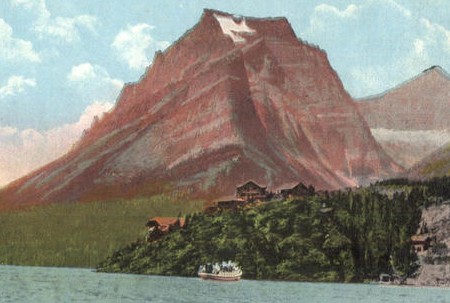
This hand-colored image, related to the one above, shows the launch on the approach to Going-to-the-Sun Chalets. This view of lodgings clinging to a cliff usually drew excited gasps of wonder from first time guests.
The complex was built on the rocks at Sun Point, about 100' above the surface of St Mary Lake. This also contributed to the experience; it felt as if the Chalets were at the edge of a great precipice, on a mountain perch among even larger mountains. With the Swiss style architecture, and waitstaff dressed as Swiss maids, the experience definitely conjured the image of the Alps that the Railway's Louis Hill was striving for.
Guests enjoyed a variety of activities, including fishing, horseback riding, archery, badminton, hiking, moderate climbing, art workshops, as well as plenty of time just relaxing. With mountains at a proximity where it seemed they could reach out and touch them, the scenery was a prime attraction at Sun Camp.
Within two years of opening, the complex was hosting about 3,000 guests per season. It was so popular that the St Mary Chalets became little more than a staging ground, filled with throngs of people twice a day as they came and went from Going-to-the-Sun. The only alternative transport to the boat launch was to ride pack horses, which made the journey even more costly. Even so, the pack trips were extremely popular. Prior to his prediction about the demands of the new roadway, Mather stated that Going-to-the-Sun would require "modern dormitory buildings, fitted with steam-heated rooms, hot and cold water, and other modern hotel conveniences" within a year or two. Upgrades and expansions continued, although not to that extent.
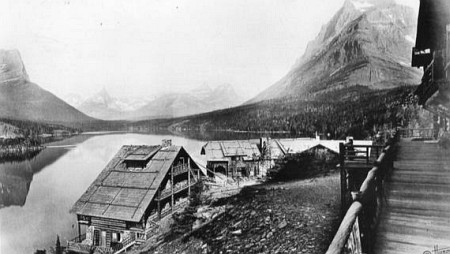
Typical scene through much of the Chalets' first 20 years: A building under construction or addition.
Usually when a highway bypasses a business, that business is doomed. At Going-to-the-Sun Chalets the result was exactly the opposite. Upon completion in 1933, Going-to-the-Sun Highway went right by the front door of the Chalets. Rather than spike demand as Mather predicted, this accessibility killed it.
The location was no less spectacular, and it did stop most of the traffic bound for Logan Pass and the west side of the park. Most guests still arrived by boat, but more and more were opting for the convenience of their own vehicles. And thus Sun Camp was no longer a difficult destination, but a convenient stop on the way to more destinations. Motorists would stop for lunch or a spin through the curio shoppe, lingering for a few moments to admire the view. Then it was off to the next thing. More awaits...back in the car, off we go. Besides, the new tourist camps offered "auto cabins," and that's all that was really needed after a day of exploring. The Chalets, with separate lodging, bathhouses, and dining areas, were simply too time consuming for the modern motorist. The number of overnight guests sank like a stone.
For a few years the Great Northern continued to promote the Chalets, refusing to compete head-to-head with the private auto cabins. But it quickly became apparent that "progress" was unstoppable, and plans were made to meet public demand for the new style lodging. The railway opened the East Glacier Auto Cabins in 1940, which were the final nail in the Sun Camp's coffin. The two operations competed for about a year, with lodging and meals at Going-to-the-Sun Chalets costing up to three times as much as the auto cabins. As evidence of their popularity, the auto cabins reopened after World War II, while Going-to-the-Sun Chalets did not. Today it is likely that would be reversed, as more and more people recognize the symbiosis between parks and traditional park lodging. The Auto Cabins, incidentally, continue to operate as the Rising Sun Motor Inn.
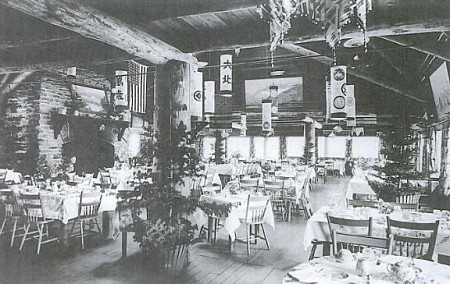
Above, the dining room at Going-to-the-Sun Chalets. Notice the Oriental lanterns...in the early 20th century these were considered as "western" as cowboys by easterners, due to the substantial Chinese population in California and other western states. This photo was taken prior to 1920.
Going-to-the-Sun Chalets stock had dropped considerably among Great Northern executives by the start of World War II. The structures had taken a beating from 30 years of harsh Montana winters. They required endless maintenance and repairs, and weren't considered even remotely historic or significant at the time. Unfortunately the designs were viewed as tired and obsolete in 1940. It was comparable to the way we would view an aging motel built during the 1970s: Very few people would clamor for preservation.
As troublesome as the chalet complex was in the early 1940s, there were still a few in management who pointed to growth and profit in the recent past, but all that did was stave off demolition for a couple years. The Going-to-the-Sun Chalets stood empty after the war, and were ultimately razed in 1948. Sun Point has been returned to a (sort of) natural state; it takes an archaeologist's eye to recognize the traces of the Chalets.
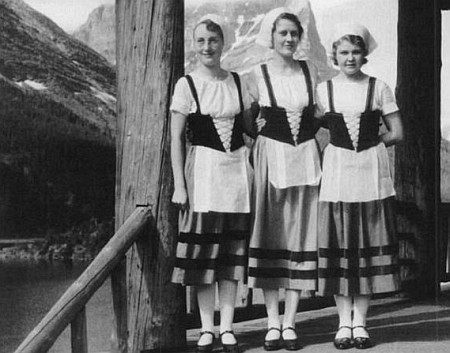
Above, waitresses and other staff at Sun Camp dressed in a Swiss theme, and were often used in promotional photographs.
